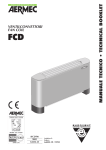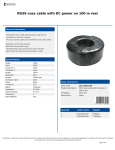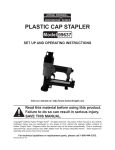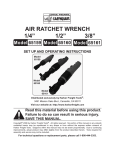Download TRANSMISSION FLUID EXCHANGER
Transcript
TRANSMISSION FLUID EXCHANGER Model 93019 SET UP AND OPERATING INSTRUCTIONS Visit our website at: http://www.harborfreight.com Read this material before using this product. Failure to do so can result in serious injury. SAVE THIS MANUAL. Copyright© 2010 by Harbor Freight Tools®. All rights reserved. No portion of this manual or any artwork contained herein may be reproduced in any shape or form without the express written consent of Harbor Freight Tools. Diagrams within this manual may not be drawn proportionally. Due to continuing improvements, actual product may differ slightly from the product described herein. Tools required for assembly and service may not be included. For technical questions or replacement parts, please call 1-800-444-3353. Manual Revised 10f NOTICE is used to address practices not related to personal injury. SAVE THIS MANUAL Keep this manual for the safety warnings and precautions, assembly, operating, inspection, maintenance and cleaning procedures. Write the product’s serial number in the back of the manual near the assembly diagram (or month and year of purchase if product has no number). Keep this manual and the receipt in a safe and dry place for future reference. a. IMPORTANT SAFETY INFORMATION Keep the work area clean and well lighted. Cluttered benches and dark areas increase the risks of electric shock, fire, and injury to persons. b. Do not operate the tool in explosive atmospheres, such as in the presence of flammable liquids, gases, or dust. The tool is able to create sparks resulting in the ignition of the dust or fumes. c. Keep bystanders, children, and visitors away while operating the tool. Distractions are able to result in the loss of control of the tool. In this manual, on the labeling, and all other information provided with this product: This is the safety alert symbol. It is used to alert you to potential personal injury hazards. Obey all safety messages that follow this symbol to avoid possible injury or death. DANGER indicates a hazardous situation which, if not avoided, will result in death or serious injury. WARNING indicates a hazardous situation which, if not avoided, could result in death or serious injury. CAUTION, without the safety alert symbol, is used to address practices not related to personal injury. Work area Personal safety a. Stay alert. Watch what you are doing and use common sense when operating the tool. Do not use the tool while tired or under the influence of drugs, alcohol, or medication. A moment of inattention while operating the tool increases the risk of injury to persons. b. Dress properly. Do not wear loose clothing or jewelry. Contain long hair. Keep hair, clothing, and gloves away from moving parts. Loose clothes, jewelry, or long hair increases the risk of injury to persons as a result of being caught in moving parts. c. Do not overreach. Keep proper footing and balance at all times. Proper footing and balance enables CAUTION, used with the safety alert symbol, indicates a hazardous situation which, if not avoided, could result in minor or moderate injury. SKU 93019 For technical questions, please call 1-800-444-3353. Page 2 better control of the tool in unexpected situations. d. Use safety equipment. A dust mask, non-skid safety shoes and a hard hat must be used for the applicable conditions. Wear heavy-duty work gloves during use. Maintain the tool with care. Keep a cutting tool sharp and clean. A properly maintained tool, with sharp cutting edges reduces the risk of binding and is easier to control. f. Check for misalignment or binding of moving parts, breakage of parts, and any other condition that affects the tool’s operation. If damaged, have the tool serviced before using. Many accidents are caused by poorly maintained tools. There is a risk of bursting if the tool is damaged. g. Use only accessories that are identified by the manufacturer for the specific tool model. Use of an accessory not intended for use with the specific tool model, increases the risk of injury to persons. Always wear eye protection. Wear ANSI-approved safety goggles. e. f. e. Always wear hearing protection when using the tool. Prolonged exposure to high intensity noise is able to cause hearing loss. Tool use and care a. b. c. d. Do not force the tool. Use the correct tool for the application. The correct tool will do the job better and safer at the rate for which the tool is designed. Do not use the tool if the switch does not turn the tool on or off. Any tool that cannot be controlled with the switch is dangerous and must be repaired. Disconnect the tool from the air source before making any adjustments, changing accessories, or storing the tool. Such preventive safety measures reduce the risk of starting the tool unintentionally. Turn off and detach the air supply, safely discharge any residual air pressure, and release the throttle and/or turn the switch to its off position before leaving the work area. Store the tool when it is idle out of reach of children and other untrained persons. A tool is dangerous in the hands of untrained users. SKU 93019 Service a. Tool service must be performed only by qualified repair personnel. b. When servicing a tool, use only identical replacement parts. Use only authorized parts. c. Use only the lubricants supplied with the tool or specified by the manufacturer. Air source a. Never connect to an air source that is capable of exceeding 90 psi. Over pressurizing the tool may cause bursting, abnormal operation, breakage of the tool or serious injury to persons. Use only clean, dry, regulated compressed air at the rated pressure or within the rated pressure range as marked on the tool. Always verify prior to using the tool that the air source has For technical questions, please call 1-800-444-3353. Page 3 been adjusted to the rated air pressure or within the rated air-pressure range. b. Never use oxygen, carbon dioxide, combustible gases or any bottled gas as an air source for the tool. Such gases are capable of explosion and serious injury to persons. Symbol WARNING marking concerning Risk of Explosion. Specific Safety Instructions 1. The warnings and precautions discussed in this manual cannot cover all possible conditions and situations that may occur. It must be understood by the operator that common sense and caution are factors which cannot be built into this product, but must be supplied by the operator. 2. WARNING: The brass components of this product contain lead, a chemical known to the State of California to cause birth defects (or other reproductive harm). (California Health & Safety code § 25249.5, et seq.) 3. Only use with accessories rated to handle the forces exerted by this tool during operation. Other accessories not designed for the forces generated may break and forcefully launch pieces. 4. Attach all accessories properly to the tool before connecting the air supply. A loose accessory may detach or break during operation. 5. Wear ANSI-approved splash resistant safety goggles during use and maintenance. Always protect your skin and eyes from contact with oil and solvents. 6. Do not smoke near this unit. Keep a type ABC fire extinguisher nearby in case of fire. 7. Use in a well ventilated area. 8. When leaks are found in the equipment or hoses, immediately turn the air pressure off and repair the leaks. Keep SAVE THESE INSTRUCTIONS. SYMBOLS AND SPECIFIC SAFETY INSTRUCTIONS Symbol Definitions Symbol no Property or statement No-load speed .../min Revolutions or reciprocation per minute PSI Pounds per square inch of pressure ft-lb Foot-pounds of torque BPM Blows per minute CFM Cubic Feet per Minute flow SCFM Cubic Feet per Minute flow at standard conditions NPT National pipe thread, tapered NPS National pipe thread, straight WARNING marking concerning Risk of Eye Injury. Wear ANSI-approved eye protection. WARNING marking concerning Risk of Hearing Loss. Wear hearing protection. WARNING marking concerning Risk of Respiratory Injury. Wear NIOSHapproved dust mask/respirator. Chart continued in next column. SKU 93019 Property or statement For technical questions, please call 1-800-444-3353. Page 4 an empty plastic bucket nearby in case of leaks. 9. Immediately clean up any fluid spills or leaks. 10. Do not exceed the recommended 90 PSI operating air pressure. This could damage equipment or create a hazardous situation. that common sense and caution are factors which cannot be built into this product, but must be supplied by the operator. SAVE THESE INSTRUCTIONS. 11. When cleaning, only use cleaning compounds made for use with transmissions. 12. Empty all new and used fluid from the system, disconnect the air supply, and ensure that the system is not pressurized before changing the fluid filter or performing any other maintenance or repair procedures to the Transmission Oil Exchanger. 13. Industrial applications must follow OSHA guidelines. 14. Obey the manual for the air compressor used to power this tool. 15. Install an in-line shutoff valve to allow immediate control over the air supply in an emergency, even if a hose is ruptured. 16. Maintain labels and nameplates on the compressor. These carry important safety information. If unreadable or missing, contact Harbor Freight Tools for a replacement. 17. This product is not a toy. Keep it out of reach of children. 18. Operate unit on level surface only. 19. The warnings, precautions, and instructions discussed in this instruction manual cannot cover all possible conditions and situations that may occur. It must be understood by the operator SKU 93019 For technical questions, please call 1-800-444-3353. Page 5 SPECIFICATIONS Working Air Pressure 70-90 PSI Air Inlet 1/4” - 18 NPT Air Consumption 5.3 CFM @ 90 PSI Storage Capacity Accessories UNPACKING Two 8-Gallon Storage Tanks 2 Fluid Collecting Bottles 24 Fitting and Adapters 8 Assorted Hoses 1 Tool Box 1 Spare Oil Filter When unpacking, make sure that the item is intact and undamaged. If any parts are missing or broken, please call Harbor Freight Tools at 1-800-444-3353 as soon as possible. COMPONENTS AND CONTROLS Used Oil View Flow New Oil View Flow Oil Fill Cap Air Pressure Gauge Pump Pressure Gauge Air Input Pressure / Recycle Control Used Oil Tank Air Pressure Regulator Control Filling / Recycle Control New Oil Input Hose Connector Pressure Adapter Quick Connector New Oil Tank Fill Gauge Fill Gauge SKU 93019 Return Adapter Quick Connector For technical questions, please call 1-800-444-3353. Page 6 INITIAL TOOL SET UP/ ASSEMBLY Coupler Plug Exchanger Read the ENTIRE IMPORTANT SAFETY INFORMATION section at the beginning of this manual including all text under subheadings therein before set up or use of this product. Quick Coupler Valve Quick Coupler 1. • This air tool may be shipped with a protective plug covering the air inlet. Remove this plug before set up. Air Supply TO PREVENT EXPLOSION: Use only clean, dry, regulated, compressed air to power this tool. Do not use oxygen, carbon dioxide, combustible gases, or any other bottled gas as a power source for this tool. SKU 93019 Filter Regulator with Pressure Gauge Recommended Air Line Components Unpacking Dryer Air Hose on Reel Air Compressor Note: For additional information regarding the parts listed in the following pages, refer to the Assembly Diagram near the end of this manual. When unpacking, make sure that the item is intact and undamaged. If any parts are missing or broken, please call Harbor Freight Tools at 1-800-444-3353 as soon as possible. Coupler Plug Incorporate a filter, regulator with pressure gauge, dryer, in-line shutoff valve, and quick coupler for best service, as shown in the diagram above. An inline shutoff ball valve is an important safety device because it controls the air supply even if the air hose is ruptured. The shutoff valve should be a ball valve because it can be closed quickly. Note: An oiler system should not be used with this tool. 2. Turn the Fluid Exchanger air regulator counterclockwise to shut off air supply to pump; refer to Operation section for description of controls. 3. Close the in-line shutoff valve between the compressor and the Fluid Exchanger. 4. Attach an air hose to the compressor’s air outlet. Connect the air hose to the air inlet of the tool. Other components, such as a coupler plug and quick coupler, will make operation more efficient, but are not required. For technical questions, please call 1-800-444-3353. Page 7 Note: Air flow, and therefore tool performance, can be hindered by undersized air supply components. 5. The air hose must be long enough to reach the work area with enough extra length to allow free movement while working. 6. Turn on the air compressor according to the manufacturer’s directions and allow it to build up pressure until it cycles off. 7. Adjust the air compressor’s output regulator so that the air output is enough to properly power the tool, but the output will not exceed the tool’s maximum air pressure at any time. Adjust the pressure gradually, while checking the air output gauge to set the right pressure range. 8. If the tool requires more force to accomplish the task, verify that the tool receives sufficient, unobstructed airflow (CFM) and increase the pressure (PSI) output of the regulator up to the maximum air pressure rating of this tool. 9. CAUTION! TO PREVENT TOOL AND ACCESSORY FAILURE, RESULTING IN INJURY: Do not exceed the tool’s maximum air pressure rating (90 PSI). If the tool still does not have sufficient force at maximum pressure and sufficient airflow, then a larger tool may be required. 10. Inspect the air connections for leaks. Repair any leaks found. 11. If the Fluid Exchanger will not be used at this time, turn off and detach the air supply, safely discharge any residual air pressure, and turn the switch to its off position to prevent accidental operation. Note: Residual air pressure should not be present after the tool is disconnected SKU 93019 from the air supply. However, it is a good safety measure to attempt to discharge the tool in a safe fashion after disconnecting to ensure that the Fluid Exchanger is disconnected and unpowered OPERATING INSTRUCTIONS Read the ENTIRE IMPORTANT SAFETY INFORMATION section at the beginning of this manual including all text under subheadings therein before set up or use of this product. Tool Set Up TO PREVENT SERIOUS INJURY FROM ACCIDENTAL OPERATION: Disconnect and remove air supply before performing any inspection, maintenance, or cleaning procedures. TO PREVENT SERIOUS INJURY: DO NOT OPERATE WITH ANY GUARD DISABLED, DAMAGED, OR REMOVED. Moving guards must move freely and close instantly. Do not start the vehicle engine in a closed garage or any other sealed structure. Carbon monoxide is produced during operation and is deadly in a closed environment. Early signs of carbon monoxide poisoning resemble the flu, with headaches, dizziness, or nausea. If you have any of these signs get fresh air immediately. For technical questions, please call 1-800-444-3353. Page 8 a secondary transmission cooler in addition to the cooler in the radiator. See Figure 1, below. Work Piece and Work Area Set Up 1. 2. Designate a work area that is clean and well-lit. The work area must not allow access by children or pets to prevent distraction and injury. There must not be objects, such as utility lines, nearby that will present a hazard while working 3. NOTE: Circulate (bleed) any remaining test oil in Fluid Exchanger before using. 4. If needed, place vehicle on a hoist or on secure vehicle stands in a well ventilated area. 5. Set vehicle emergency brake and turn engine off. 6. Locate and identify the transmission cooling line. Transmission cooling systems are essentially the same from one vehicle to another, though they may be routed differently or the fittings might be in slightly different locations. See Figure 1, below. 7. Refer to the vehicle manufacturer’s maintenance manual and adhere to all safety warnings and instructions in this manual. 8. Place the Fluid Exchanger to one side of the vehicle. Lock the Locking Swivel Casters (30). 9. Turn on the air compressor (not supplied) and place its hose next to the Exchanger. 10. Have new transmission fluid or cleaning solvent ready for use near the Exchanger. Making Vehicle Service Connections 1. In some systems, both lines will run to the bottom of the radiator, as with radiators that have top and bottom tanks. Some cooling systems will have Connection 1 (see Figure 2) is the fitting at the transmission. Connection 2 is Upper Transmission Fitting Upper Transmission Fitting Upper Radiator Fitting Lower Transmission Fitting Lower Transmission Fitting Secondary Transmission Cooler Cooling Lines Cooling Lines Typical Vehicle Cooling System The fittings required vary based on vehicle make and often from model to model. WARNING! Make sure vehicle is shut off and cool. Do not open a transmission system that is hot and under pressure. See Figure 2 (next page) for standard hookup connections. Lower Radiator Fitting Vehicle Cooling System With Secondary Transmission Cooler Figure 1 SKU 93019 For technical questions, please call 1-800-444-3353. Page 9 Connection 1: Transmission Fitting Connection 2: Upper/Lower Radiator Fitting Upper Transmission Fitting Upper Radiator Fitting Cooling Lines Lower Transmission Fitting Connection 3: Upper/Lower Cooling Line Lower Radiator Fitting Hookup Top Radiator Line Typical Cooling Connection Locations Figure 2 the fitting at the radiator. Connection 3 shows a spot (typical to foreign vehicles) where a rubber hose changes to a steel tubing line. 8. Radiator Please note: There must be a removable hose clamp at this location in order to make a connection. Only a few vehicles will be serviced at this location. 2. For the connection steps, we will use a guide for a 1992 Chevrolet 4-Door Blazer, as shown in Figure 2, above. 3. First, verify the transmission fluid level is normal before you begin. 4. Look for the easiest spot to break into the transmission system (any existing connection along the entire system can be used, as shown in Figure 2, above.) 5. If available, use a transmission cooling line wrench (such as an open end wrench, flare nut wrench, or adjustable wrench) to remove the transmission cooling line from the radiator. 6. 7. Examine the vehicle fittings and compare them to the one shown on the Fitting Chart on page 16 of this manual. Connect required fitting into radiator and then connect required female fitting onto the vehicle transmission cooling line. SKU 93019 The red delivery line is attached to the fitting just installed on the radiator. See Figure 3, below. Fitting Red Line Figure 3 9. NOTE: The connections only need to be snug fit. Torquing down hard is not required, they should be tight enough to keep the connections from leaking. If they begin to leak, see the Troubleshooting section on page 14. 10. Connect the black return hose to the fitting just installed on the transmission cooling line. This is the same line that was removed from the radiator (as mentioned in Step 5). See Figure 4. Cooling Line Return Hose Fitting Figure 4 For technical questions, please call 1-800-444-3353. Page 10 11. Make certain the hose clamp is tightened on the inside of the hose clamp flare on each fitting. This will keep the hose form coming off. 12. WARNING! Do not overtighten the adapter hose clamps. Doing so will damage the hose ends over a period of time. Clamp the hoses down with a snug fit only. See Troubleshooting section if there are still leaks. 13. Connect red (pressure) and black (return) lines to corresponding quick couplers on the Fluid Exchanger. See Figure 5. You are not required to account for fluid flow when making connection. The Exchanger will sense the vehicle’s fluid direction and send used fluid from vehicle so that it flows into the used oil tank and send new oil from new oil tank and to vehicle’s transmission. Once red and black service hoses have been connected, the system should look as shown in Fig. 5. Filling Cleaning Fluids 1. Make Service Connections as previously described. 2. Using one of the Adapter Kit clear hoses or the second Red Hose, connect it to the New Oil Input Hose Connector. Insert the other end into the solvent container (to the bottom). Refer to the vehicle manufacturer’s maintenance manual for approved cleaning solvents. 3. Turn the Pressure Recycle Control knob to the Pressure position. 4. Turn the Recycle-Filling Control knob to the Filling position. 5. Connect the air compressor line hose to the Air Input Quick Connector on the Fluid Exchanger. 6. While viewing the Air Pressure Gauge, pull up on the Air Pressure Regulator Control knob and adjust the air pressure to between 40 and 90 PSI. (Check the required pressure in the vehicle manufacturer’s maintenance manual.) The cleaning solvent in now injected into the transmission. NOTE: With some make and models of the vehicle being serviced, the use of other included fittings and/or hoses may be needed to make service connections. Transfer Hoses Figure 5 SKU 93019 For technical questions, please call 1-800-444-3353. Page 11 7. Turn the (left) Pressure Recycle Control knob to the Recycle position. 8. Turn the (right) Filling-Recycle Control knob to the Recycle position. 9. Start the engine to begin the cleaning process. This should take five minutes. During this process, view the fluid flow through the View Flow tubes. 10. Turn the engine off after five minutes. Control knob and adjust the air pressure to between 40 and 90 PSI. The air pressure will force the new oil into the transmission, and the old oil will be forced into the Used Oil Tank. (During this process, view the new and used oil flow. They should flow in and out at equal rates. Adjust the air pressure, if necessary, to accommodate this.) 9. 11. Remove the air compressor line and remove hose from the side “Filling” coupler. 12. Begin steps for the Oil Exchange Cycle. During the oil transfer process, with your foot securely holding down the brake, switch gears in sequential order, starting with first gear. Keep in each gear for 10 seconds. Oil Exchange Cycle 1. Leave the Black Hose (return) and the Red Hose (pressure) connected as described in the previous steps, but disconnect the hose to the New Oil Input Hose Connector. See Figure 3, below. 2. Review the vehicle manufacturer’s maintenance manual for the correct type and amount of transmission fluid oil. 3. NOTE: Verify Fluid Exchanger system has been purged. 4. Remove the Oil Fill Cap on the top of the Fluid Exchanger and pour in the correct amount of new transmission fluid oil. View the amount of fluid filling the New Oil Tank Gauge. 5. Turn the Pressure Recycle Control knob to the Pressure position. 6. Turn the Recycle-Filling Control knob to the Recycle position. 7. Connect the air compressor line hose to the Air Input Quick Connector. 8. While viewing the Air Pressure Gauge, pull up on the Air Pressure Regulator SKU 93019 Start the engine and view the oil flow through the New and Used Oil View Flow tubes. When the color of the oil is has shifted from light brown (old oil) to red (newer oil) in both tubes, the process is complete. 10. Turn the engine off and remove air line. 11. Reconnect the vehicle oil output (return) line from the transmission to the input of the automatic transmission cooler. Securely tighten clamps. Make certain that the transmission is properly filled and not overfilled before using the vehicle. Emptying Old Oil 1. Using an Adapter Hose from the kit, connect one end to the New Oil Input Hose Quick Connector, and the other end to the Return Adapter Quick Connector. 2. Connect a Black Hose to Pressure Adapter Quick Connector. Place other end of the Black Hose in an appropriate disposal tank of adequate size. 3. Turn the Pressure-Recycle Control knob to the Pressure position. For technical questions, please call 1-800-444-3353. Page 12 4. Turn the Recycle-Filling Control knob to the Filling position. 5. Connect the air compressor line hose to the Air Input Quick Connector. 6. While viewing the Air Pressure Gauge, pull up on the Air Pressure Regulator Control knob and adjust the air pressure to between 40 and 90 PSI. View the used oil movement from the Used Oil View Flow tube. 7. When all used oil is removed from the Used Oil Tank, remove the air line from the. Remove the other hoses as well. 8. Dispose of used oil and solvents in a proper manner as dictated by local environmental codes. USER-MAINTENANCE INSTRUCTIONS Cleaning, Maintenance, and Lubrication Note: These procedures are in addition to the regular checks and maintenance explained as part of the regular operation of the air-operated tool. 1. Daily - Air Supply Maintenance: Every day, perform maintenance on the air supply according to the component manufacturers’ instructions. If needed, the lubricator’s oil level needs to be maintained. And the moisture filter must be regularly drained. Performing routine maintenance on the air supply will allow the tool to operate more safely and will also reduce wear on the tool. 2. Drain all hoses that were used in an appropriate oil disposal tank. 3. When finished using the Fluid Exchanger, coil the Red and Black Hoses and place in the side holder. Place the Adapter Fittings and Hoses back in their case. Store the case in the top-back of the Fluid Exchanger. 4. Before each use, discharge any water accumulation from the air compressor tank. A water filter on the air compressor is recommended. 5. When oil flow through the Fluid Exchanger very slowly, even with higher air pressure, replace the Fluid Exchanger’s oil filter 6. Quarterly (every 3 months): Have the pump cleaned and inspected, by a qualified technician. Procedures not specifically explained in this manual must be performed only by a qualified technician. TO PREVENT SERIOUS INJURY FROM ACCIDENTAL OPERATION: Turn off the tool, detach the air supply, safely discharge any residual air pressure in the tool, and turn the switch to its off position before performing any inspection, maintenance, or cleaning procedures. TO PREVENT SERIOUS INJURY FROM TOOL FAILURE: Do not use damaged equipment. If abnormal noise, vibration, or leaking air occurs, have problem corrected before further use. SKU 93019 For technical questions, please call 1-800-444-3353. Page 13 Troubleshooting Problem Possible Causes Decreased output. 1. Not enough air pressure and/ or air flow. Likely Solutions 1. Check for loose connections and make sure that air supply is providing enough air flow (CFM) at required pressure (PSI) to the tool’s air inlet. Do not exceed maximum air pressure of 90 PSI. 2. Clean air inlet screen of buildup. 2. Blocked air inlet screen (if equipped). 3. Air leaking from pump housing 3. Make sure the pump is properly assembled and tight. or fittings. 4. Pump contaminated. 4. Inspect and clean pump. Install in-line filter in air supply as stated in Initial Set Up: Air Supply. 5. Fluid lines kinked or bent. 5. Straighten fluid lines. 1. Incorrect settings of control 1. Adjust control knobs to correct settings. knobs. 2. Incorrect (reversed) hose 2. Verify direction of oil inlet and oil return hoses correct; installation. adjust if necessary. 1. Incorrect components and/or 1. Verify correct fittings are being sued with correct fittings installed. vehicle transmission system. Hoses are connected, but oil flow is not seen from view tubes. Severe air leakage. (Slight air leakage is normal, 2. Damaged hoses and/or 2. Replace damaged hoses and/or fittings. especially on older fittings. tools.) 3. Air leaking from pump housing. 3. Make sure the pump is properly assembled and tight Follow all safety precautions whenever diagnosing or servicing the tool. Disconnect air supply before service. Record Product’s Serial Number Here: Note: If product has no serial number, record month and year of purchase instead. Note: Some parts are listed and shown for illustration purposes only, and are not available individually as replacement parts. SKU 93019 For technical questions, please call 1-800-444-3353. Page 14 Adapter and Fitting Kit Parts List SKU 93019 For technical questions, please call 1-800-444-3353. Page 15 PLEASE READ THE FOLLOWING CAREFULLY THE MANUFACTURER AND/OR DISTRIBUTOR HAS PROVIDED THE PARTS LIST AND ASSEMBLY DIAGRAM IN THIS MANUAL AS A REFERENCE TOOL ONLY. NEITHER THE MANUFACTURER OR DISTRIBUTOR MAKES ANY REPRESENTATION OR WARRANTY OF ANY KIND TO THE BUYER THAT HE OR SHE IS QUALIFIED TO MAKE ANY REPAIRS TO THE PRODUCT, OR THAT HE OR SHE IS QUALIFIED TO REPLACE ANY PARTS OF THE PRODUCT. IN FACT, THE MANUFACTURER AND/OR DISTRIBUTOR EXPRESSLY STATES THAT ALL REPAIRS AND PARTS REPLACEMENTS SHOULD BE UNDERTAKEN BY CERTIFIED AND LICENSED TECHNICIANS, AND NOT BY THE BUYER. THE BUYER ASSUMES ALL RISK AND LIABILITY ARISING OUT OF HIS OR HER REPAIRS TO THE ORIGINAL PRODUCT OR REPLACEMENT PARTS THERETO, OR ARISING OUT OF HIS OR HER INSTALLATION OF REPLACEMENT PARTS THERETO. PARTS LIST Part 1 2 3 4 5 6 7 8 9 10 11 12 13 14 15 16 17A 18A Description Oil Fill Cap O-Seal Gauge, Oil Pressure, 16 kgs Gauge, Pump Pressure, 16 kgs Gauge Stand Quick Connector, PCF10-02 Connector, PCF8-02 Elbow Connector, PL12-02 1/4” Elbow Connector (Cu) PU Hose, Ø12 3-Way Connector, PD10-02 Air Inlet Connector, 1/4” Male 1/4” Mail Quick Couplet, SM20 1/4” Connector, PC8-02 1/4” Connector, PC10-02 Connector, PL8-02 Connector, PL10-04 Three-Way Ball Valve (Cu) SKU 93019 Qty. 1 1 1 1 2 3 1 4 2 2 4 1 3 1 5 2 6 2 Part 19A 20A 21 22 23 24 25 26 27 28 29 30 31 32 33 34 35 Description Knob Connector Knob Pressure Regulator Three-Way Connector, PD8-02 Connector, PL10-02 Filter Cover Filter Silencer Complete Set of Pump Main Body Wheels Casters With Brake Screws (M8) 1/4” Female Quick Couple, SF20 1/4” Male Quick Connector, PM20 Oil delivery hose with 2 red, 1 black connectors (not shown) Tool Box For technical questions, please call 1-800-444-3353. Qty. 2 2 1 1 2 1 2 1 1 1 2 2 16 3 3 3 1 Page 16 ASSEMBLY DIAGRAM 35 34 SKU 93019 For technical questions, please call 1-800-444-3353. Page 17 Hose Connection Diagram SKU 93019 For technical questions, please call 1-800-444-3353. Page 18 90 Day Warranty Harbor Freight Tools Co. makes every effort to assure that its products meet high quality and durability standards, and warrants to the original purchaser that this product is free from defects in materials and workmanship for the period of 90 days from the date of purchase. This warranty does not apply to damage due directly or indirectly, to misuse, abuse, negligence or accidents, repairs or alterations outside our facilities, criminal activity, improper installation, normal wear and tear, or to lack of maintenance. We shall in no event be liable for death, injuries to persons or property, or for incidental, contingent, special or consequential damages arising from the use of our product. Some states do not allow the exclusion or limitation of incidental or consequential damages, so the above limitation of exclusion may not apply to you. THIS WARRANTY IS EXPRESSLY IN LIEU OF ALL OTHER WARRANTIES, EXPRESS OR IMPLIED, INCLUDING THE WARRANTIES OF MERCHANTABILITY AND FITNESS. To take advantage of this warranty, the product or part must be returned to us with transportation charges prepaid. Proof of purchase date and an explanation of the complaint must accompany the merchandise. If our inspection verifies the defect, we will either repair or replace the product at our election or we may elect to refund the purchase price if we cannot readily and quickly provide you with a replacement. We will return repaired products at our expense, but if we determine there is no defect, or that the defect resulted from causes not within the scope of our warranty, then you must bear the cost of returning the product. This warranty gives you specific legal rights and you may also have other rights which vary from state to state. 3491 Mission Oaks Blvd. • PO Box 6009 • Camarillo, CA 93011 • (800) 444-3353 SKU 93019 For technical questions, please call 1-800-444-3353. Page 19




























